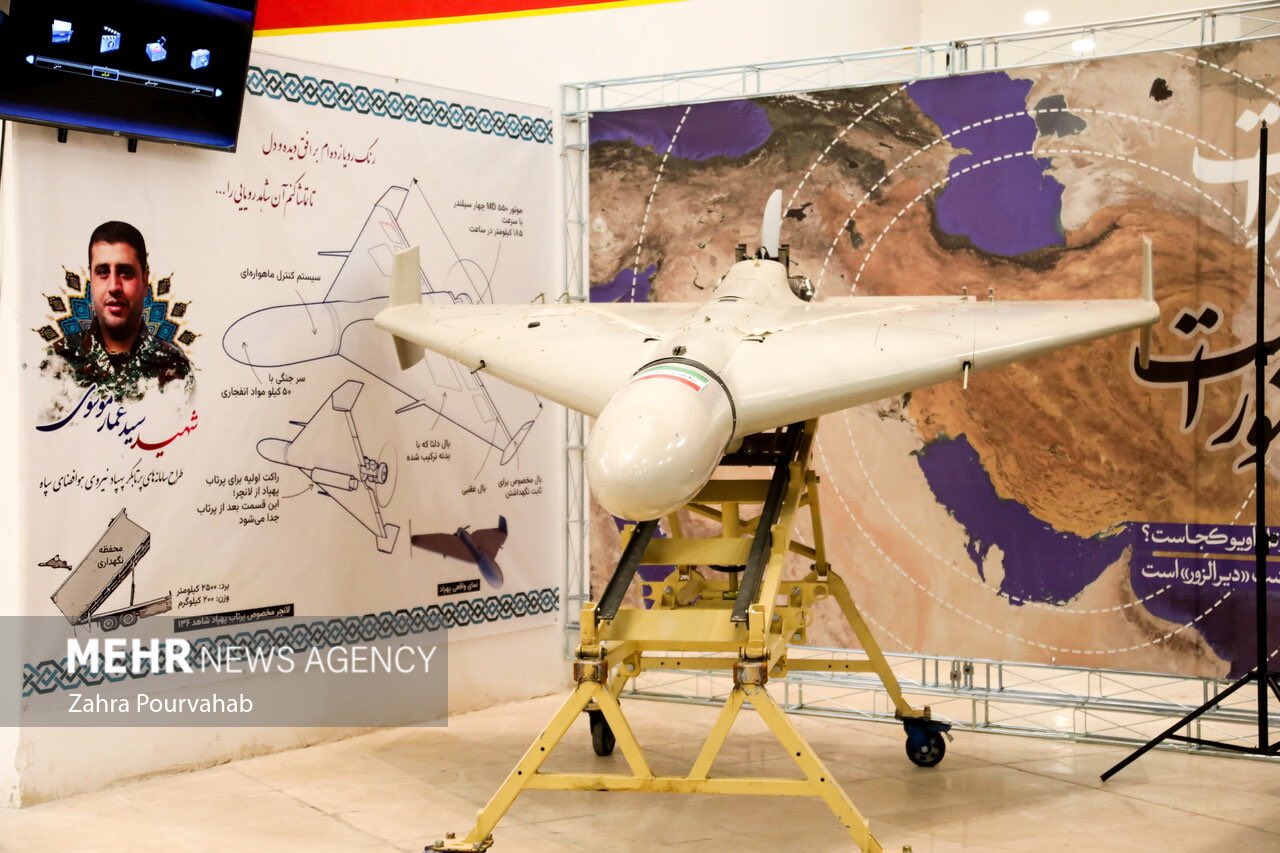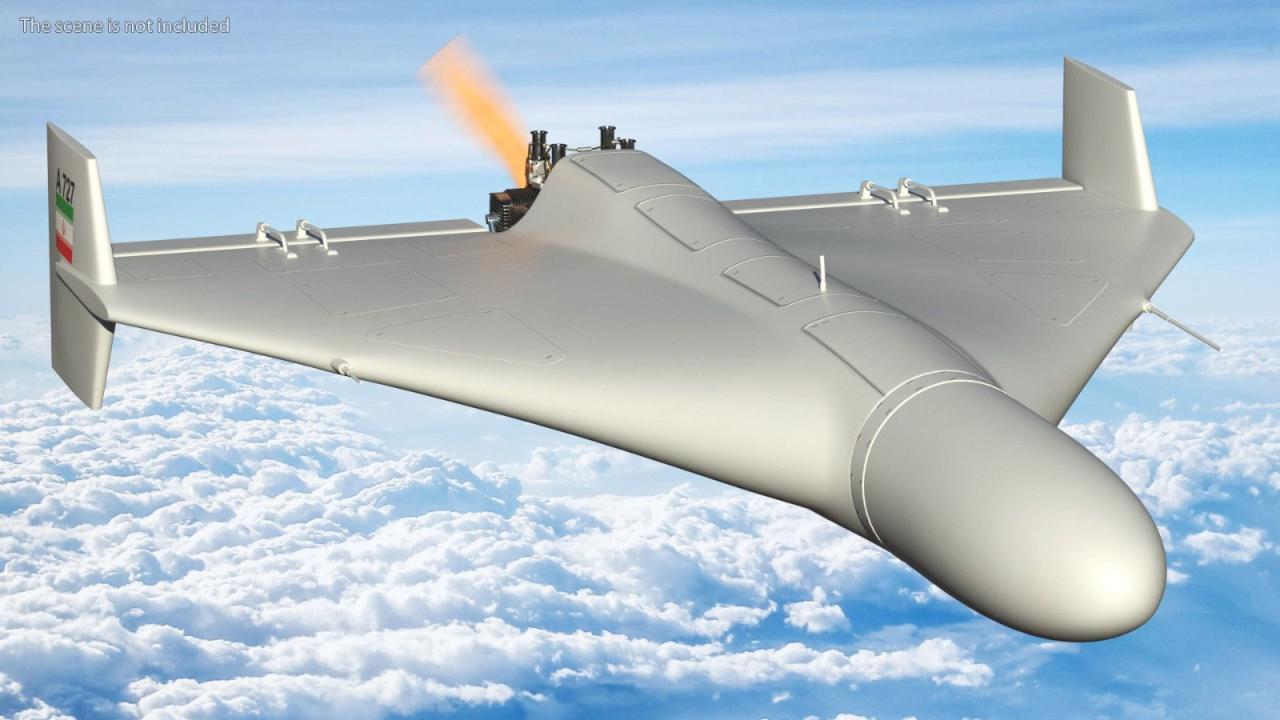Shahed drones have emerged as a significant player in modern warfare, prompting global concern and intense scrutiny. These relatively inexpensive unmanned aerial vehicles (UAVs) possess surprising capabilities, impacting conflicts across the globe. Understanding their technical specifications, operational capabilities, manufacturing processes, deployment strategies, and the consequences of their use is crucial for comprehending their impact on geopolitical landscapes and military tactics.
Their low cost and relative ease of production contribute to their widespread proliferation, raising concerns about their potential for misuse and the challenges of effective countermeasures. This exploration delves into the multifaceted nature of Shahed drones, examining their design, deployment, impact, and the ongoing efforts to mitigate their threats.
The Shahed drone, a relatively inexpensive and readily available unmanned aerial vehicle, has gained notoriety for its use in various conflicts. Incidents involving similar drones raise concerns about airspace security, as highlighted by a recent event where a drone was shot down in New Jersey; you can read more about this incident at nj drone shot down.
The ease of acquisition and deployment of Shahed drones, coupled with such incidents, underscores the need for improved counter-drone technologies and stricter regulations.
Shahed Drone Technical Specifications
The Shahed drone, also known by various designations including Shahed-136 and Geran-2, is a low-cost, expendable unmanned aerial vehicle (UAV) employed primarily for loitering munition attacks. Understanding its technical specifications is crucial to analyzing its capabilities and effectiveness.
Physical Dimensions, Weight, and Materials
The Shahed drone is relatively small and lightweight, designed for ease of transport and deployment. Estimates place its length at approximately 3.5 meters and its wingspan around 2.5 meters. Its construction primarily utilizes composite materials, contributing to its lightweight yet relatively robust design. The precise weight varies depending on payload, but estimations range from approximately 200 to 250 kilograms.
Propulsion System
The drone’s propulsion system is a key factor in its operational range and endurance. It employs a small, relatively low-power internal combustion engine, likely fueled by a mixture of gasoline and oil. The fuel capacity allows for a flight duration of several hours, though this is dependent on factors such as wind speed and altitude.
Payload Capacity and Warheads
The Shahed drone’s primary function is as a loitering munition, meaning it carries a high-explosive warhead. The payload capacity is estimated to be around 50 kilograms, allowing for a significant explosive yield. While the exact type of warhead varies, it is believed to be a high-explosive fragmentation warhead designed for maximum area effect upon impact.
Comparison with Similar Drones
A comparison with similar loitering munitions highlights the Shahed drone’s position in the market. While precise specifications for competing systems are often classified, a general comparison can be made.
| Drone Model | Wingspan (m) | Weight (kg) | Payload (kg) |
|---|---|---|---|
| Shahed-136 | ~2.5 | ~200-250 | ~50 |
| (Competitor A – placeholder) | ~3.0 | ~250-300 | ~40 |
| (Competitor B – placeholder) | ~2.0 | ~150-200 | ~30 |
Shahed Drone Operational Capabilities
The operational capabilities of the Shahed drone are a complex interplay of its technical specifications and deployment tactics. Understanding these aspects provides insight into its overall effectiveness.
Range and Endurance
The Shahed drone boasts a considerable range, estimated to be in excess of 1000 kilometers under optimal conditions. However, this range can be significantly affected by factors such as wind speed, altitude, and payload. Endurance, similarly, is dependent on these factors, but generally allows for several hours of flight time.
Navigation System
The Shahed drone’s navigation system relies heavily on GPS for precise location and path planning. Inertial navigation systems may provide backup capabilities in the event of GPS signal disruption, but their accuracy is generally lower over extended flight times.
Communication Systems
Communication between the drone and its operator is crucial for effective control and data transmission. The exact communication systems employed remain somewhat classified, but it is believed to utilize both satellite and radio frequency links for both command and control as well as data transmission regarding its target.
Flight Control Mechanisms
The drone utilizes a relatively simple flight control system, relying on aerodynamic surfaces and possibly rudimentary autopilot capabilities. Its effectiveness is largely dependent on environmental conditions, with strong winds and adverse weather significantly impacting its stability and precision.
Shahed Drone Manufacturing and Production
The manufacturing and production of the Shahed drone are shrouded in some secrecy, but available information provides a glimpse into the process and its associated complexities.
Manufacturers and Organizations
The primary manufacturer is believed to be an Iranian entity, although the precise organization remains somewhat unclear. There are also indications of potential involvement from other countries or organizations in the supply chain and technology transfer aspects.
Production Process and Cost, Shahed drone
The production process appears to be relatively streamlined, focusing on cost-effectiveness and mass production. Estimates suggest the unit cost of a Shahed drone is relatively low, contributing to its affordability and widespread deployment. The exact cost remains classified, but estimates place it in the low thousands of US dollars per unit.
Supply Chain for Components
The supply chain for Shahed drone components is likely complex, involving various international suppliers for key components such as engines, electronics, and materials.
- Engine components
- Electronic control systems
- Composite materials for airframe
- Navigation and communication equipment
- Warhead components
Technology Transfer

The technology transfer aspects of Shahed drone production are a subject of ongoing investigation and debate. There are concerns about the potential spread of this technology to other actors, leading to increased proliferation of similar weapons systems.
Shahed Drone Deployment and Tactics
The deployment and tactical employment of Shahed drones have evolved over time, reflecting both the capabilities of the drone and the responses of its adversaries. Analyzing these aspects provides insight into the drone’s effectiveness in various conflict scenarios.
Deployment Methods
Shahed drones are typically deployed from land-based launchers, often involving simple mobile platforms that allow for rapid deployment and relocation. The launch procedure is relatively straightforward, minimizing the time required to prepare and launch the drone.
Operational Tactics
Operators often utilize swarm tactics, employing multiple drones simultaneously to overwhelm defenses. This approach also helps to increase the likelihood of at least some drones successfully reaching their targets, despite countermeasures.
The Shahed drone, known for its inexpensive yet effective design, highlights the growing accessibility of drone technology. This accessibility extends to the broader market of drones with cameras, such as those showcased on sites like drone with camera , which offer a range of capabilities for both civilian and military applications. Understanding the technology behind these consumer-grade devices provides context for evaluating the capabilities and limitations of drones like the Shahed.
Effectiveness of Countermeasures
The effectiveness of countermeasures against Shahed drones varies. Electronic warfare systems can disrupt communication and navigation, while physical countermeasures such as anti-drone weapons and nets can physically neutralize the drones. The success of these countermeasures depends heavily on factors such as detection range, reaction time, and the sophistication of the countermeasures themselves.
Comparison of Deployment Strategies

The deployment strategies employed in various conflicts demonstrate the adaptability of the Shahed drone. The following table provides a brief overview, although precise details are often unavailable due to the classified nature of military operations.
| Conflict | Deployment Tactics | Effectiveness | Countermeasures Employed |
|---|---|---|---|
| (Conflict A – placeholder) | Swarm attacks, targeting infrastructure | Moderate success | Electronic warfare, anti-drone systems |
| (Conflict B – placeholder) | Precision strikes, targeting military assets | Limited success | Air defenses, electronic jamming |
Shahed Drone Impact and Consequences
The widespread use of Shahed drones has had significant human, economic, political, and environmental consequences. Understanding these impacts is crucial for assessing the overall implications of this technology.
Human and Economic Costs
Shahed drone attacks have resulted in significant human casualties and substantial economic damage. The destruction of infrastructure, disruption of services, and the cost of repairs and reconstruction contribute to substantial economic losses.
Political and Strategic Implications
The proliferation of Shahed drones has significant political and strategic implications. It lowers the barrier to entry for employing relatively sophisticated military technology, potentially destabilizing regional conflicts and escalating tensions between nations.
Examples of Damage
Numerous instances of damage caused by Shahed drones have been documented in various conflicts. These include damage to energy infrastructure, military bases, and civilian targets, resulting in both physical destruction and significant disruption.
Environmental Impact
The debris from downed Shahed drones poses an environmental hazard. The scattered remnants of the drone, including potentially hazardous materials, require careful cleanup and disposal to minimize environmental damage.
Shahed Drone Countermeasures and Defense Strategies
Effective countermeasures and defense strategies are essential to mitigate the threat posed by Shahed drones. A multi-layered approach is typically required to achieve optimal protection.
Electronic Warfare Systems

Electronic warfare systems play a crucial role in disrupting Shahed drone operations. Jamming signals, spoofing GPS data, and employing other electronic countermeasures can significantly reduce the effectiveness of these drones.
Physical Countermeasures
Physical countermeasures, such as anti-drone weapons and nets, offer a direct means of neutralizing Shahed drones. These systems can shoot down or capture the drones, preventing them from reaching their targets.
Detection and Tracking
Early detection and tracking of Shahed drones are critical for effective defense. Radar systems, acoustic sensors, and other detection technologies play a crucial role in providing timely warnings and guiding countermeasures.
Best Practices for Defense
Effective defense against Shahed drones requires a multi-layered approach, combining various detection, tracking, and neutralization methods. Best practices include:
- Investing in advanced detection systems
- Deploying a combination of electronic and physical countermeasures
- Implementing robust communication and coordination protocols
- Conducting regular training exercises
- Developing and maintaining comprehensive defense strategies
Shahed Drone Technological Advancements and Future Developments
The Shahed drone technology is constantly evolving, with potential for significant advancements in the future. These advancements could further enhance the drone’s capabilities and effectiveness, while also posing new challenges for defense systems.
Potential Future Improvements
Future improvements might include enhanced range, payload capacity, and navigation systems. Improvements in stealth capabilities and resistance to countermeasures are also likely areas of development.
Integration of Artificial Intelligence
The integration of artificial intelligence (AI) could significantly enhance Shahed drone capabilities. AI-powered systems could improve autonomous navigation, target recognition, and decision-making, leading to more effective and adaptable drones.
Increased Autonomy and Swarm Capabilities
Future iterations of Shahed drones may exhibit increased autonomy and swarm capabilities. This would allow for more coordinated and complex attacks, making them even more difficult to defend against.
Reported Upgrades and Modifications
Reports suggest ongoing upgrades and modifications to the Shahed drone design. These changes may include improvements to engine performance, payload capacity, and countermeasure resistance. The precise nature of these upgrades is often kept confidential for operational security reasons.
The Shahed drone, a seemingly simple weapon, has profoundly impacted modern conflict. Its affordability, range, and destructive potential have redefined asymmetric warfare, forcing a reassessment of defense strategies and highlighting the complex ethical and geopolitical implications of readily available drone technology. Further research and development of effective countermeasures remain critical in mitigating the threats posed by this evolving technology.
Question & Answer Hub
How accurate are Shahed drones?
Their accuracy is debated, with reports varying. Generally, they are considered less precise than more advanced military drones, often relying on sheer numbers to overwhelm defenses.
What is the lifespan of a Shahed drone?
The operational lifespan varies depending on usage and maintenance, but generally, they are considered expendable, designed for single missions.
Are Shahed drones easily detected?
Detection depends on the technology employed. While their relatively small size and low radar signature make detection challenging, advancements in radar and electronic warfare systems are improving detection capabilities.
What are the ethical concerns surrounding Shahed drones?
Ethical concerns include the potential for civilian casualties due to their relatively low accuracy and the ease with which they can be used in attacks, lowering the barrier to entry for armed conflict.
